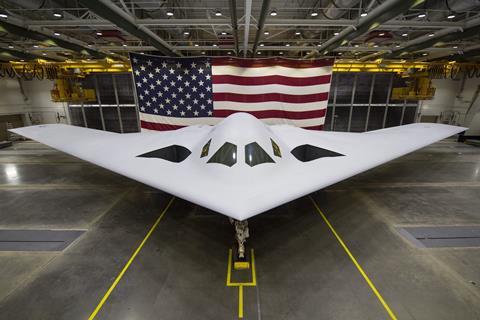A think tank report suggests that US long-range strikes, including the use of strategic bombers, could push China to cross the nuclear threshold in the event of a conflict between the two nations.
In a series of reports, Rand Corporation raises the issues involved with long-range strike, particularly using bombers such as the developmental Northrop Grumman B-21.

Rand notes that Beijing has a “no first use” policy for its nuclear weapons. Still, this policy is probably not fixed, especially should a conflict, such as an attempted Chinese invasion over neighbouring Taiwan, go poorly.
Rand contends that in such a conflict it would be desirable for long-range strike to focus primarily on denying access to the island, thus limiting the need for strikes on Mainland China that could be mis-perceived and prompt nuclear escalation.
“Chinese perceptions of long-range strike could be particularly tricky to manage given both the historic US propensity to use long-range strike for extensive coercive bombing campaigns and its visibility,” says Rand.
“Bombers are also manned platforms, so there is individual responsibility to execute missions as planned. During a conflict, bomber pilots might have to make choices that could have immensely consequential cascading effects.”
The reports, entitled Denial Without Disaster, make several recommendations.
One is to “rebrand” the B-21 as a “multi-role” platform, and not a strategic one.
Rand also suggests that the US Air Force may need to be careful with its deception techniques when making strikes. While deception could overwhelm China’s ability to discriminate real aircraft from decoys, the impression that vast numbers of bombers and cruise missiles are inbound could precipitate nuclear use.
Given that the Chinese Communist Party’s main priority is holding onto power, the USA would have to be mindful about not creating the impression that “decapitation” strikes targeting regime leadership are underway.
“Munitions that have limited military application should be purchased in small numbers, and aircraft that are not highly survivable are at high risk of being perceived as designed for first strike,” contends Rand.
“Hypersonic weapons appear primed to stoke Chinese fears about decapitation strikes early in a conflict, even if the United States intends to use them for other targets.”
Rand adds that in a conflict with China, the USA needs to avoid massing long-range strike platforms and their support elements at specific locations, as this may invite a nuclear strike.
In addition, long-range strike missions should avoid antagonising other hostile nuclear powers, for instance by flying bombers over North Korea that are intended to strike targets in China.
“Our work suggests a variety of options for using US joint long-range strike during a defence-of-Taiwan scenario in ways that should help decrease escalation risks,” says Rand.
“Some of these options might entail some decrease in operational utility or force survivability but still enable a denial theory of victory.”


























